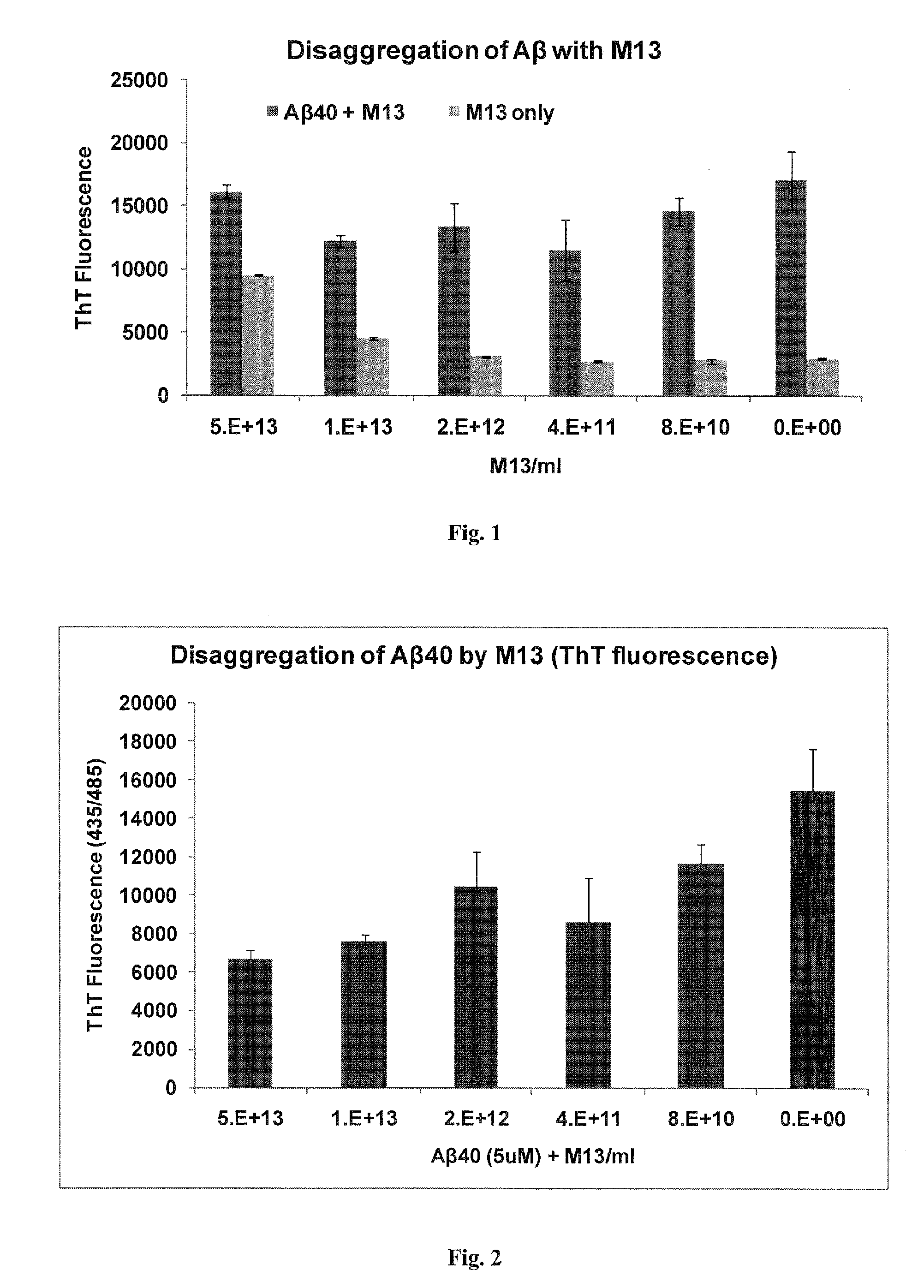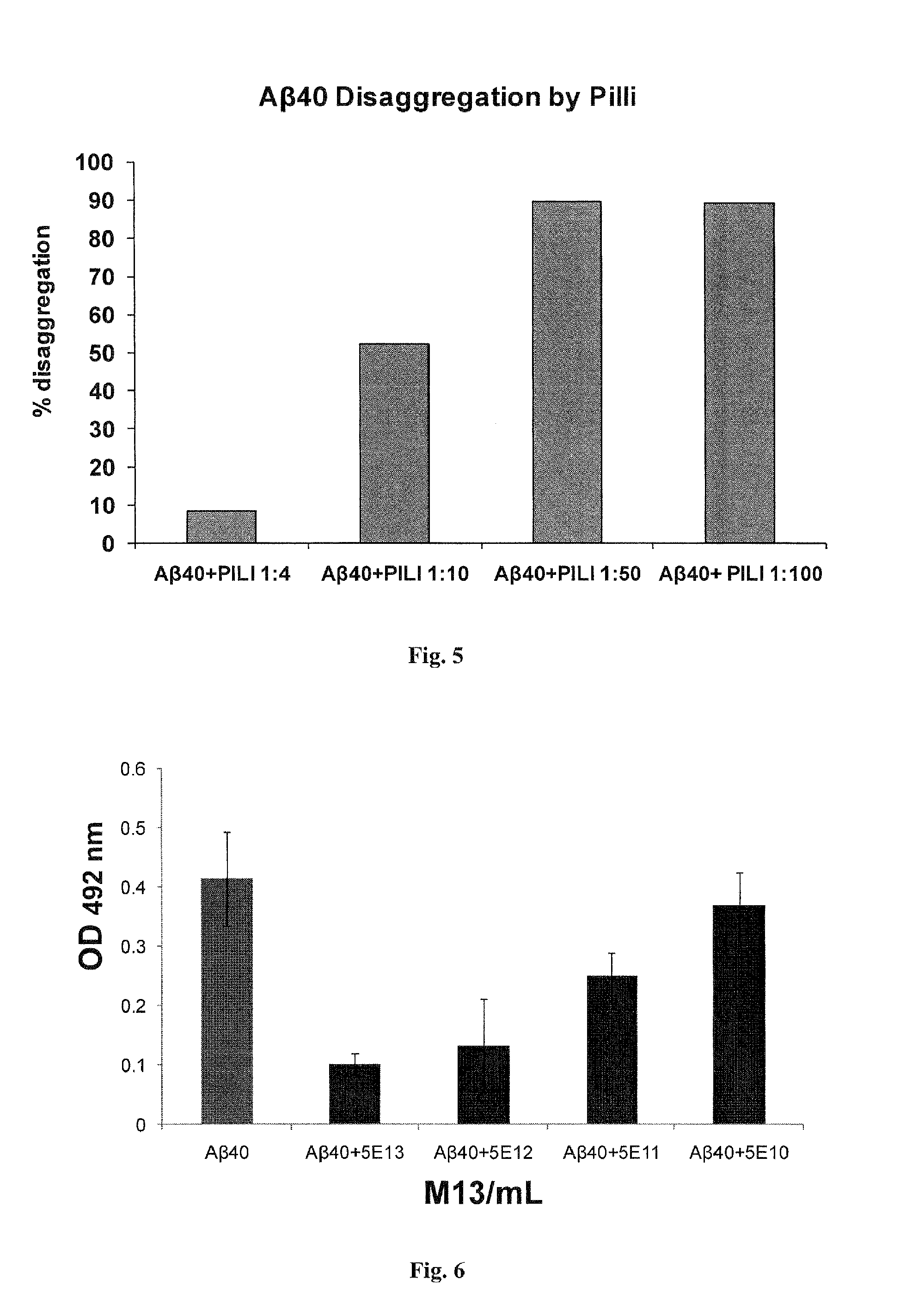Method for treating disease characterized by plaque
a plaque disease and plaque technology, applied in the field of neurodegenerative diseases, can solve the problems of not many well-structured models of toxicity mechanisms, insertion of aggregates into the cell membranes, and more severe and widespread abnormalities,
- Summary
- Abstract
- Description
- Claims
- Application Information
AI Technical Summary
Benefits of technology
Problems solved by technology
Method used
Image
Examples
example 1
ThT Assay for Quantification of Filamentous Agent Disaggregation Activity
[0067]Thioflavin (ThT) assay is a common tool to quantify the formation of amyloid fibril of Aβ (Levine, 1999). The assay is based on the fluorescence shift of thioflavin upon interaction with β-sheet structure. Aggregated Aβ forms a β-sheet structure that is lacking in the monomer state of the peptide. Interaction with ThT molecules induces a specific fluorescence of ThT at−485nm. This assay is used to follow aggregation and disaggregation of Aβ. If a substance disaggregates Aβ fibrils, then the ThT fluorescence is reduced relative to intact Aβ fibrils.
[0068]Aβ1-40 preparation: 1 mg Aβ1-40 (Bachem, H-1194) is dissolved in 1 ml acetonitrile: water:trifluoroacetic acid (80:20:0.1% / v:v:v) and aliquoted to sterile 1 ml tubes (100 μg peptide / tube). Samples are frozen in liquid nitrogen and lyophilized. Dry samples are kept sealed with parafilm at −20° C.
[0069]Aβ1-40 aggregation: Aβ40 (100 u...
example 2
ELISA Trap Protocol for Measuring Aggregated Aβ (β-Amyloid)
[0083]This ELISA Trap assay is also useful for detecting disaggregation. It measures uniquely polyvalent β-amyloid, and is based oh an assay published by LeVine (2004). By comparing β-amyloid aggregates remaining after incubation with a putative disaggregating agent, such as M13, TMV, and fimbriae, compared to aggregates remaining after incubation with a negative control, such as saline, it is possible to measure the extent of disaggregation. In other words, this is a useful assay for screening agents that promote amyloid disaggregation.
[0084]Aβ1-40 preparation: Aβ1-40 (Bachem, H-1194, 1 mg) is dissolved in 1 ml acetonitrile: water: trifluoroacetic acid (80:20:0.1% v:v:v) and aliquoted to sterile 1 ml tubes (100 μg peptide / tube). Samples are frozen in liquid nitrogen and lyophilized. Dry samples are kept sealed with parafilm at −20 C.
[0085]Aβ1-40 aggregation: Aβ40 (100 μg, 50 μM) is dissolved in DMSO (30 μl) and diluted in u...
PUM
| Property | Measurement | Unit |
|---|---|---|
| Width | aaaaa | aaaaa |
| Width | aaaaa | aaaaa |
| Nanoscale particle size | aaaaa | aaaaa |
Abstract
Description
Claims
Application Information
 Login to View More
Login to View More - R&D
- Intellectual Property
- Life Sciences
- Materials
- Tech Scout
- Unparalleled Data Quality
- Higher Quality Content
- 60% Fewer Hallucinations
Browse by: Latest US Patents, China's latest patents, Technical Efficacy Thesaurus, Application Domain, Technology Topic, Popular Technical Reports.
© 2025 PatSnap. All rights reserved.Legal|Privacy policy|Modern Slavery Act Transparency Statement|Sitemap|About US| Contact US: help@patsnap.com



